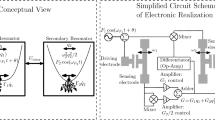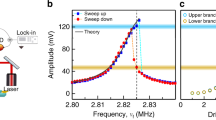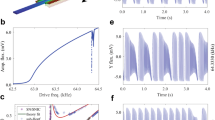Abstract
We conside the dynamics of a nonlinear resonator that is nonlinearly coupled to a linear resonator that has a relatively short decay time. In this case, the secondary (linear) resonator adiabatically tracks the primary (nonlinear) resonator. This model, which is motivated by ongoing experimental work in nano-resonators, is analyzed analytically and numerically to show that the linear and nonlinear characteristics of the primary resonator can be altered in a significant manner by the coupling to the secondary resonator. Such an arrangement may provide a practical means of tuning resonator characteristics in applications.





Similar content being viewed by others
References
Torteman, B., Kessler, Y., Liberzon, A., Krylov, S.: Micro-beam resonator parametrically excited by electro-thermal Joule’s heating and its use as a flow sensor. Nonlinear Dyn. 1–15 (2019). https://doi.org/10.1007/s11071-019-05031-4
Krakover, N., Maimon, R., Tepper-Faran, T., Gerson, Y., Rand, R., Krylov, S.: Mechanical superheterodyne and its use for low frequency vibrations sensing. J. Microelectromech. Syst. 28(3), 362 (2019)
Pelliccia, L., Cacciamani, F., Farinelli, P., Sorrentino, R.: High-\(Q\) tunable waveguide filters using ohmic RF MEMS switches. IEEE Trans. Microw. Theory Tech. 63(10), 3381 (2015)
Kostsov, E., Sokolov, A.: Gigahertz MEMS clock generator. Optoelectron. Instrum. Data Process. 55(2), 154 (2019)
Rebeiz, G.M., Muldavin, J.B.: RF MEMS switches and switch circuits. IEEE Microw. Mag. 2(4), 59 (2001)
Rebeiz, G.M.: RF MEMS: theory, design, and technology. Wiley, New York (2004)
Nguyen, C.T.C.: MEMS technology for timing and frequency control. In: Proceedings of the 2005 IEEE International Frequency Control Symposium and Exposition, 2005.(IEEE, 2005), p. 11
Van Beek, J., Puers, R.: A review of MEMS oscillators for frequency reference and timing applications. J. Micromech. Microeng. 22(1), 013001 (2011)
Rhoads, J.F., Shaw, S.W., Turner, K.L.: Nonlinear dynamics and its applications in micro-and nanoresonators. J. Dyn. Syst. Meas. Control 132(3), 034001 (2010)
Cho, H., Jeong, B., Yu, M.F., Vakakis, A.F., McFarland, D.M., Bergman, L.A.: Nonlinear hardening and softening resonances in micromechanical cantilever-nanotube systems originated from nanoscale geometric nonlinearities. Int. J. Solids Struct. 49(15–16), 2059 (2012)
Ruzziconi, L., Younis, M.I., Lenci, S.: An efficient reduced-order model to investigate the behavior of an imperfect microbeam under axial load and electric excitation. J. Comput. Nonlinear Dyn. 8(1), 011014 (2013)
Zeng, J., Garg, A., Kovacs, A., Bajaj, A.K., Peroulis, D.: An equation-based nonlinear model for non-flat MEMS fixed-fixed beams with non-vertical anchoring supports. J. Micromech. Microeng. 25(5), 055018 (2015)
Abdel-Rahman, E.M., Younis, M.I., Nayfeh, A.H.: Characterization of the mechanical behavior of an electrically actuated microbeam. J. Micromech. Microeng. 12(6), 759 (2002)
Younis, M.I., Nayfeh, A.: A study of the nonlinear response of a resonant microbeam to an electric actuation. Nonlinear Dyn. 31(1), 91 (2003)
Lifshitz, R., Cross, M.: Nonlinear dynamics of nanomechanical and micromechanical resonators. Rev. Nonlinear Dyn. Complex. 1, 1 (2008)
Dykman, M., Krivoglaz, M.: Spectral distribution of nonlinear oscillators with nonlinear friction due to a medium. Phys. Status Solidi (b) 68(1), 111 (1975)
Zaitsev, S., Shtempluck, O., Buks, E., Gottlieb, O.: Nonlinear damping in a micromechanical oscillator. Nonlinear Dyn. 67(1), 859 (2012)
Amabili, M.: Derivation of nonlinear damping from viscoelasticity in case of nonlinear vibrations. Nonlinear Dyn. 93(1), 5–18 (2018)
Dykman, M., Krivoglaz, M.: Theory of nonlinear oscillator interacting with a medium. Sov. Phys. Rev. 5, 265 (1984)
Levantino, S., Samori, C., Zanchi, A., Lacaita, A.L.: AM-to-PM conversion in varactor-tuned oscillators. IEEE Trans. Circuits Syst. II: Analog Digit. Signal Process. 49(7), 509 (2002)
Eichler, A., Moser, J., Chaste, J., Zdrojek, M., Wilson-Rae, I., Bachtold, A.: Nonlinear damping in mechanical resonators made from carbon nanotubes and graphene. Nat. Nanotechnol. 6(6), 339 (2011)
DeMartini, B.E., Rhoads, J.F., Turner, K.L., Shaw, S.W., Moehlis, J.: Linear and nonlinear tuning of parametrically excited MEMS oscillators. J. Microelectromech. Syst. 16(2), 310 (2007)
Saghafi, M., Dankowicz, H., Lacarbonara, W.: Nonlinear tuning of microresonators for dynamic range enhancement. Proc. R. Soc. A 471(2179), 20140969 (2015)
Li, L.L., Polunin, P.M., Dou, S., Shoshani, O., Scott Strachan, B., Jensen, J.S., Shaw, S.W., Turner, K.L.: Tailoring the nonlinear response of MEMS resonators using shape optimization. Appl. Phys. Lett. 110(8), 081902 (2017)
Antonio, D., Zanette, D.H., López, D.: Frequency stabilization in nonlinear micromechanical oscillators. Nat. Commun. 3, 806 (2012)
Güttinger, J., Noury, A., Weber, P., Eriksson, A.M., Lagoin, C., Moser, J., Eichler, C., Wallraff, A., Isacsson, A., Bachtold, A.: Energy-dependent path of dissipation in nanomechanical resonators. Nat. Nanotechnol. 12(7), 631 (2017)
Chen, C., Zanette, D.H., Czaplewski, D.A., Shaw, S., López, D.: Direct observation of coherent energy transfer in nonlinear micromechanical oscillators. Nat. Commun. 8, 15523 (2017)
Shoshani, O., Shaw, S.W., Dykman, M.I.: Anomalous decay of nanomechanical modes going through nonlinear resonance. Sci. Rep. 7(1), 18091 (2017)
Einstein, A., Hopf, L.: Statistical investigation of a resonator’s motion in a radiation field. Ann. Phys. 33, 1105 (1910)
Bogolyubov, N.: On some statistical methods in mathematical physics. Izdat. Akad. Nauk Ukr. SSR Kiev 1, 115–137 (1945)
Atalaya, J., Kenny, T.W., Roukes, M., Dykman, M.: Nonlinear damping and dephasing in nanomechanical systems. Phys. Rev. B 94(19), 195440 (2016)
Caldeira, A.O., Leggett, A.J.: Path integral approach to quantum Brownian motion. Phys. A: Stat. Mech. Its Appl. 121(3), 587 (1983)
Matheny, M., Villanueva, L., Karabalin, R., Sader, J.E., Roukes, M.: Nonlinear mode-coupling in nanomechanical systems. Nano Lett. 13(4), 1622 (2013)
Zhang, M., Wiederhecker, G.S., Manipatruni, S., Barnard, A., McEuen, P., Lipson, M.: Synchronization of micromechanical oscillators using light. Phys. Rev. Lett. 109(23), 233906 (2012)
Nayfeh, A.H., Mook, D.T.: Nonlinear Oscillations. Wiley, New York (2008)
Guckenheimer, J., Holmes, P.J.: Nonlinear Oscillations, Dynamical Systems, and Bifurcations of Vector Fields, vol. 42. Springer, Berlin (2013)
Dirac, P.A.M.: The Principles of Quantum Mechanics, vol. 27. Oxford University Press, Oxford (1981)
Novotny, L.: Strong coupling, energy splitting, and level crossings: a classical perspective. Am. J. Phys. 78(11), 1199 (2010)
Pardo, M., Sorenson, L., Ayazi, F.: An empirical phase-noise model for MEMS oscillators operating in nonlinear regime. IEEE Trans. Circuits Syst. I: Regul. Pap. 59(5), 979 (2012)
Agrawal, D.K., Seshia, A.A.: An analytical formulation for phase noise in MEMS oscillators. IEEE Trans. Ultrason. Ferroelectr. Freq. Control 61(12), 1938 (2014)
Pankratz, E., Sánchez-Sinencio, E.: Survey of integrated-circuit-oscillator phase-noise analysis. Int. J. Circuit Theory and Appl. 42(9), 871 (2014)
Sobreviela, G., Vidal-Álvarez, G., Riverola, M., Uranga, A., Torres, F., Barniol, N.: Suppression of the Af-mediated noise at the top bifurcation point in a MEMS resonator with both hardening and softening hysteretic cycles. Sens. Actuators A: Phys. 256, 59 (2017)
Dykman, M., Krivoglaz, M.: Classical theory of nonlinear oscillators interacting with a medium. Phys. Status Solidi (b) 48(2), 497 (1971)
Habib, S., Kandrup, H.E.: Nonlinear noise in cosmology. Phys. Rev. D 46(12), 5303 (1992)
Millonas, M.M.: Self-consistent microscopic theory of fluctuation-induced transport. Phys. Rev. Lett. 74(1), 10 (1995)
Hänggi, P.: Generalized Langevin equations: a useful tool for the perplexed modeller of nonequilibrium fluctuations? In: Schimansky-Geier, L., Pöschel, T. (eds.) Stochastic Dynamics, pp. 15–22. Springer, Berlin (1997)
Funding
SWS acknowledges partial support from the National Science Foundation (Grants Nos. CMMI 1561829 and CMMI 1662619). MID acknowledges partial support from the National Science Foundation (Grants Nos. CMMI 1661618 and DMR 1806473).
Author information
Authors and Affiliations
Corresponding author
Ethics declarations
Conflict of interest
The authors declare that they have no conflict of interest.
Additional information
Publisher's Note
Springer Nature remains neutral with regard to jurisdictional claims in published maps and institutional affiliations.
Appendix A: Brief discerption of the microscopic theory of a resonator that interacts with a medium
Appendix A: Brief discerption of the microscopic theory of a resonator that interacts with a medium
We consider the total Hamiltonian of a nonlinear resonator with a potential U(x) that is coupled to a medium of harmonic oscillators. The analysis is well-known [16, 19, 31, 32, 43,44,45,46]; here, we briefly outline it for completeness. The total Hamiltonian includes the resonator Hamiltonian \(\mathcal {H}_r\), the medium Hamiltonian \(\mathcal {H}_m\), and the interaction Hamiltonian \(\mathcal {H}_\mathrm{inter}\) and reads
The equations of motion resulting from Eq. (25) are
We formally solve Eq. (27) in terms of its Green’s function, i.e.,
Upon inserting Eq. (28) into Eq. (26), we find that
where
Using integration by parts, we can rewrite Eq. (30) as
We assume that the medium contains an infinite number of harmonic oscillators with a continuous spectrum. Consequently, we approximate the sum over k as an integral. Toward this end, we define the spectral density of the bath as \(g(\omega )\mathrm{d}\omega =\sum _{\omega<\omega _k<\omega +\mathrm{d}\omega }\epsilon _k^{2}/\omega _{k}^2\).
Using Eq. (32) along with the assumption of a continuous spectrum of the medium, we rewrite Eq. (29) as
where \(\varGamma (t-\tau )=\int _{-\infty }^{\infty }g(\omega )\cos (\omega (t-\tau ))\mathrm{d}\omega \) is the memory of the friction, \(V_\mathrm{ren}(x)=U(x)+\frac{1}{2}G^2(x)\int _{-\infty }^{\infty }g(\omega )\mathrm{d}\omega \) is the renormalized potential of the resonator, and \(\tilde{F}=F+G(x(0))\int _{-\infty }^{\infty }g(\omega )\cos (\omega t)\mathrm{d}\omega \) is a noise term.
The statistical properties of the noise term F are determined as follows: We assume that at \(t=0\), the interaction between the bath and the resonator is turned on and considers an ensemble of initial states in which x(0) is held fixed but the initial bath variables \(q_k(0),p_k(0)\) are drawn at random from a canonical distribution characterized by a temperature T, i.e.,
With this conditional probability for the bath variables, the noise term F obeys the fluctuation–dissipation relations
and hence, it is a colored Gaussian noise. Note that for a flat spectrum of the bath weighted with the coupling (the so-called Ohmic dissipation), we can use the Markovian approximation, where \(\varGamma (t-\tau )=2\langle g\rangle \delta (t-\tau )\) and \(\langle g\rangle /\pi \) is the averaged value of the spectrum. Hence, Eq. (33) reduces to
and F becomes a white Gaussian noise.
Comparison between Eqs. (14) and (36) reveals that, for both cases of discrete and continuous spectrum baths, the linear coupling is the source of the induced linear damping and the shift in the eigenfrequency of the resonator, and the nonlinear coupling leads to nonlinear damping and modifications in the nonlinear conservative terms of the resonator. However, for the case of a continuous spectrum bath there are also fluctuating back-action terms that come along with the damping terms and balance them, i.e., the linear damping is associated with an additive noise term \(2\langle g\rangle G'^2(0)\dot{x}\longleftrightarrow G'(0)\tilde{F}\) and the nonlinear damping with a multiplicative noise \(2\langle g\rangle [G'^2(x)-G'^2(0)]\dot{x}\longleftrightarrow [G'(x)-G'(0)]\tilde{F}\).
Rights and permissions
About this article
Cite this article
Shoshani, O., Dykman, M.I. & Shaw, S.W. Tuning linear and nonlinear characteristics of a resonator via nonlinear interaction with a secondary resonator. Nonlinear Dyn 99, 433–443 (2020). https://doi.org/10.1007/s11071-019-05194-0
Received:
Accepted:
Published:
Issue Date:
DOI: https://doi.org/10.1007/s11071-019-05194-0




